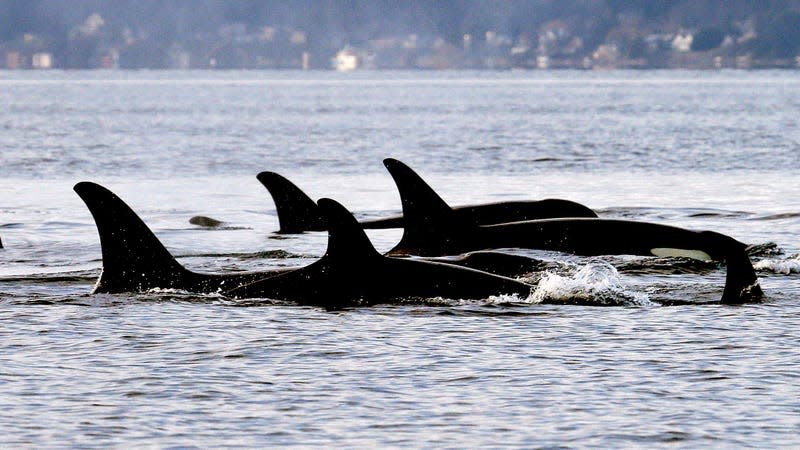What Are the Orcas Planning Next?

As orcas know well, there’s strength in numbers.
It’s been a big week (f)in orca news. The black and white cetaceans, often referred to as killer whales, seem to be making some unexpected moves—popping up in numbers and places where they usually do not.
On Sunday, a group of researchers—surveying the seas from a plane—spotted four whales just south of Nantucket and Martha’s Vineyard, in an area where orca sightings are exceedingly rare, according to a New York Times report. Elsewhere in New England, a fishing crew noted another orca in Cape Cod Bay near Provincetown, Massachusetts on the same day.
Read more
The northwest Atlantic Ocean’s orca population is thought to be exceedingly small—so two separate whale sightings in a single weekend is particularly notable. Perhaps, as marine mammal biologist Andrew Trites hypothesized to NYT, the uptick in orca presence is the result of locally rebounding seal and shark numbers (i.e. more orca food). Or, perhaps something else is going on.
Maybe, as my colleague Linda Codega has speculated, the whales are orcanizing. Potentially supporting Codega’s thesis: the massive pod of killer whales that were partying it up in Monterey Bay ALSO ON SUNDAY, per a report from The Guardian. About 30 orcas, representing 11 different family groups, came together off the coast of California to splash, breach, and play. “The little ones were wrestling and rolling like a bunch of puppies,” Nancy Black, a marine biologist with Monterey Bay Whale Watch and the California Killer Whale Project, told The Guardian.
Usually, orcas travel with their single family unit, in pods composed of “a few to 20" whales, according to the National Oceanic and Atmospheric Administration. Thirty of the cetaceans, many unrelated to each other, all in one place at one time—though not unheard of—is certainly unusual, Black noted.
Again it could be food-related, as many animal behaviors are. Or, maybe the California whales are up to something. Maybe the orcas—now strategically positioned near notorious centers of human wealth hoarding like Martha’s Vineyard, Cape Cod, and Silicon Valley—are taking cues from their Iberian, yacht-sinking comrades.
In early May, three orcas took down the Alboran Champagne, a Swiss yacht sailing through the Straight of Gibraltar. All four people who had been aboard the ship were rescued, but the ship wasn’t. It was the third boat that orcas had sunk off the Iberian coast in recent years. Just a few weeks later, the whales struck again, this time targeting another yacht: a 66-foot-long, British vessel called the Butey of Clyde. This boat didn’t sink, but was “severely damaged,” according to The Independent.
Both incidents come as part of a string of more than 250 run-ins, in which orcas have appeared to willfully attempt to wreck boats in the region, dating back to 2020. Though the whales’ motives remain murky, some researchers have theorized that the boat aggression is a learned behavior originating with a single, female orca named White Gladis. Some headlines have framed the attacks as “revenge” attempts over a boat collision injury White Gladis may have incurred. Though not all marine scientists are convinced.
Regardless of where the research stands, Gizmodo recommends the 1% keep their personal boats moored for the time being. The orcas have made it clear: They’re lurking near your New England vacation home and swimming beneath the surface within a commuter’s throw of San Francisco. Yacht owners be warned, the cetaceans aren’t going to take it anymore. Now if only we could get the birds on board too.
More from Gizmodo
Sign up for Gizmodo's Newsletter. For the latest news, Facebook, Twitter and Instagram.

